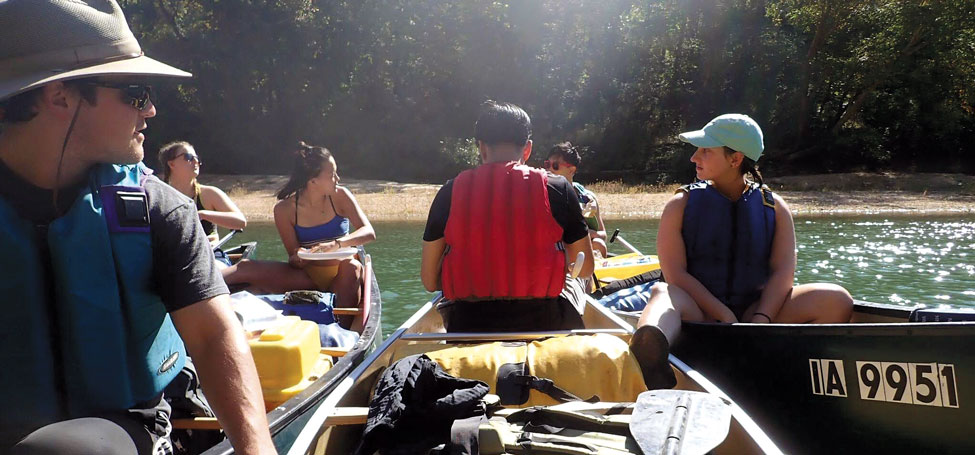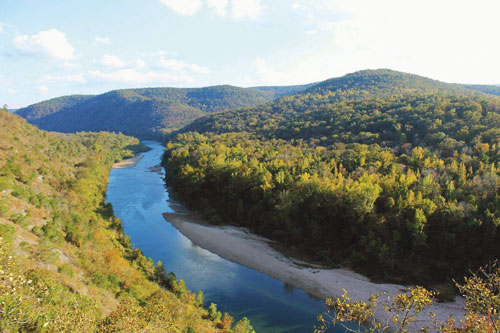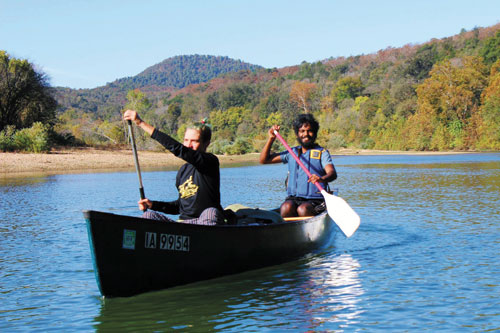
The Buffalo River Trip
During fall break for the last several years, 10 intrepid Grinnell students spend five days paddling 45 miles down a pristine national waterway in the Arkansas Ozarks. Professionally supervised by the Grinnell Outdoor Recreation Program (GORP), the Buffalo River trip is to a large extent student-planned, student-run, and student-led.
There are no grocery stores, electricity, or restroom facilities along the way. Participants take only the food and supplies their canoes can carry. While the opportunities for good times are ubiquitous, the trip is much more than a wilderness “vacation”; it’s an outdoor experience heavy on situational awareness, critical thinking, and leadership development.
Cooperative experiential learning
 “We want people to have fun, but our end goal is to provide experiential learning for students,” says Dave Zeiss, director of outdoor recreation at Grinnell. That includes opportunities to handle challenges and to look at real and perceived fears objectively.
“We want people to have fun, but our end goal is to provide experiential learning for students,” says Dave Zeiss, director of outdoor recreation at Grinnell. That includes opportunities to handle challenges and to look at real and perceived fears objectively.
“Some of the best experiential education happens on extended trips like Buffalo River,” Zeiss says. “It’s a powerful thing to have one group working together 24/7 to achieve something. It forces some group dynamics issues because you can’t keep little issues buried for five days; they come out and force people to deal with them. But it does it in a very cooperative, noncompetitive fashion.”
Identify emerging leaders
Three-year veteran Ceci Bergman ’19 says being a participant on her first trip, a leader-in-training on her second, and a team leader last fall was a “very cool transitional experience.
“When you go out into the wilderness and you don’t have the distractions of your phones or emails or school, you’re really forced to sort of ‘look in’ on the people you’re with,” Bergman says. “Sleeping in a four-person tent with people you just met a few days ago is a close experience that brings people together in a special way.”
It’s also a relaxing escape that features swimming, floating lunches, and open-fire cooking, but what Bergman considers most valuable is the focus on intentional cooperation that helps develop universal work and social skills.
“Every day we’re responsible for making sure that we eat well and drink enough water, and for keeping our bodies and minds healthy,” Bergman says. “But, for example, when you’re put in a place where it’s not necessarily easy to get water or access filtration, that extra intention focuses people’s responsibility to care for themselves and for the group.”
Safety is a foremost consideration, and Zeiss says all GORP student leaders are first aid-and CPR-certified (Bergman is additionally wilderness-certified). Buffalo River trip leaders are also largely responsible for identifying emerging leaders for future trips. Bergman says she looked specifically for participants who demonstrated “the emotional intelligence to assess the needs of the group” and a long-term commitment to the process.
Navigate a deeper experience
 Rose Caplan ’21, a leader-in-training on the 2018 trip, says the system works well both in keeping the program sustainable and promoting a sense of community.
Rose Caplan ’21, a leader-in-training on the 2018 trip, says the system works well both in keeping the program sustainable and promoting a sense of community.
“When you’re setting up camp, gathering firewood, or cooking meals, you’re sharing everyday experience on a level that’s much deeper than in a regular setting,” Caplan says. “When you’re so exhausted, you also can easily have conflicts with people. You have to navigate those because you can’t exit the situation; you’re in the middle of nowhere with only each other.
“Having the trip entirely student-run allows you to become part of the process,” she says. “It builds confidence that you’re not that different from the person who’s leading you through the wilderness.”
Beautiful, quiet, peaceful
Five to six hours of paddling per day are necessary to complete the journey, which leaves time to enjoy the surroundings. According to all sources, the aesthetics are what one would expect from a waterway in the national parks system. Some years the weather is better than others, but ‘gorgeous’ is a commonly used descriptor.
“It’s insane,” Caplan says. “The water is so clear. It’s a really beautiful teal color, and you can see straight to the bottom of the river. There are beautiful white sand banks and giant bluffs. When we go down in October, the trees are just beginning to turn a beautiful orange and it’s a crisp, perfect time of year.
“It’s also really quiet,” she says. “You’re talking to people, but there’s no noise of cars on the road or anything like that. You’re just floating and seeing beautiful surroundings and hearing the sounds of nature. It’s just nice to be there and be peaceful.”
